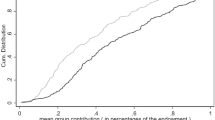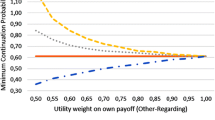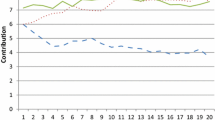Abstract
We rely on the methodology of Fischbacher et al. (Econ Lett 71(3):397–404, 2001) in order to identify subjects’ behavioral types. We then link the likelihood to act as a leader in a repeated public goods game to the elicited behavioral types. The leader in a group is defined as the subject who voluntarily decides in the first place about his contribution. The leader’s contribution is then reported publicly to the remaining group members who take their contribution decisions simultaneously. Our main findings are that leaders emerge in almost all rounds and that subjects who are identified as conditional cooperators are more likely to act as leaders than other types, e.g., free-riders or triangle-contributors. We also find that voluntary leaders, irrespective of their behavioral type, contribute always more than followers. However, the presence of leadership does not prevent the decay that is commonly observed in linear public goods experiments.




Similar content being viewed by others
Notes
Voluntary leadership was also studied by Potters et al. (2005), but in a situation of asymmetric information where the value of the MPCR was private information of the potential leader. In Dannenberg (2015) the leader was randomly selected and in one of the treatments he had the choice to lead by example (making a public binding contribution) to lead by words (making a public non-binding announcement of his contribution) or not to lead.
The first stage eliminated candidates to become a leader were allowed to modify their initially proposed contribution in stage 2.
There is some analogy between the categorization of Gächter et al. (2012) in terms of Non-Cooperators, Strong Cooperators and Weak Cooperators and the one of Fischbacher et al. (2001) which identifies CC, FR and TC types. Non-Cooperators correspond to FRs, Strong Cooperators to CC types, and Weak Cooperators to TCs.
The contribution schedule of an FR type contains ‘0’ in all 21 entries. A CC type has an increasing schedule with a Spearman’s \(\rho > 0\) at p value \({<}0.01\). A TC type has a ‘hump-shaped’ contribution schedule, first increasing up to a certain level (around 10), and decreasing afterwards. All other patterns fall in the “other” category, including unconditional positive contributions.
It was therefore no longer possible for any other group member to become a leader in that round. A limitation of this procedure is that among those who were willing to lead, the fast ones were favored over the slower ones. We, however, checked that this characteristic is not related to the type of the subject.
The show up fee is equal to 3€ or 8€ depending on whether the participant is in the location where the experiment took place or was coming from outside.
Over the ten groups, the first leadership failure occurred as late as round 8. Two failures occurred in round 14, one failure in each of the rounds 16, 17 and 18, and three failures in the final round.
The number of degrees of freedom is equal to \((r-1)(k-1)\) where r is the number of samples to compare and k the number of types.
The binomial test leads to the same conclusion.
We estimated the same model by adding the contributions of other subjects in the previous period in \(\mathbf{z}_{it}\). However, this variable was not significant and did not affect the overall results presented above.
According to a likelihood ratio test, our dynamic specification outperforms the static model. Under the null hypothesis corresponding to the static model, \(H_0 : \rho =\alpha _0 =\alpha _1 = \varvec{\alpha }_\mathbf{2} =0\), the test statistic follows a \(\chi ^{2}\) distribution with 22 degrees of freedom. The computed statistic is 93.868 and the corresponding p value almost 0, leading to the rejection of the static model in favor of our dynamic specification.
Table 2 does not report the estimates for \(\varvec{\alpha }_\mathbf{2}\) associated to \(\mathbf{z}_i\), because \(\mathbf{z}_i\) is the set of auxiliary regressors needed in modeling the distribution of individual effects conditional on the initial choice \(y_{i1}\) (following Wooldridge 2005). They are only of statistical interest (available from the authors upon request).
In order to control for a possible group composition effect for this result, we included a variable corresponding to the number of CC in the group (1, 2 or 3). Because this variable was insignificant, we decided to not report the results of the corresponding regression. We also checked that the variable corresponding to the number of FR in the group was not significant. We also estimated a model including group dummies, but it did not converge (the likelihood function was not concave). Overall, the lack of significance of group dummies can be due to our small sample size.
As pointed out by one of the reviewers, the multicollinearity between the variable “Unconditional contribution” and the subjects’ types may explain the surprising result that the unconditional contribution is negatively related to willingness to lead.
We do not include contributions of other players in the previous round in the set of explanatory variables because of multicollinearity.
References
Alpizar, F., Carlsson, F., & Johansson-Stenman, O. (2008). Anonymity, reciprocity, and conformity: Evidence from voluntary contributions to a national park in Costa Rica. Journal of Public Economics, 92(5–6), 1047–1060.
Arbak, E., & Villeval, M.-C. (2013). Voluntary leadership: Motivation and influence. Social Choice and Welfare, 40, 635–662.
Dannenberg, A. (2015). Leading by example versus leading by words in voluntary contribution experiments. Social Choice and Welfare, 44, 71–85.
Drouvelis, M., & Nosenzo, D. (2013). Group identity and leading-by-example. Journal of Economic Psychology, 39, 414–425.
Fischbacher, U., & Gächter, S. (2010). Social preferences, beliefs, and the dynamics of free riding in public good experiments. American Economic Review, 100, 541–556.
Fischbacher, U., Gächter, S., & Fehr, E. (2001). Are people conditionally cooperative? Evidence from a public goods experiment. Economics Letters, 71(3), 397–404.
Frey, B. S., & Meier, S. (2004). Social comparisons and pro-social behavior. Testing ’conditional cooperation’ in a field experiment. American Economic Review, 94(5), 1717–1722.
Gächter, S., & Renner, E. (2003). Leading by example in the presence of free rider incentives. Paper presented at a Conference on Leadership, March 2003, Lyon.
Gächter, S., & Renner, E. (2007). The role of leadership and beliefs in the voluntary provision of public goods. Mimeo: University of Nottingham.
Gächter, S., Nosenzo, D., Renner, E., & Sefton, M. (2010). Sequential versus simultaneous contributions to public goods: Experimental evidence. Journal of Public Economics, 94(7–8), 515–522.
Gächter, S., Nosenzo, D., Renner, E., & Sefton, M. (2012). Who makes a good leader? Cooperativeness, optimism and leading-by-example. Economic Inquiry, 50(4), 953–967.
Greiner, B. (2015). Subject pool recruitment procedures: Organizing experiments with ORSEE. Journal of the Economic Science Association, 1(1), 114–125.
Güth, W., Levati, M. V., Sutter, M., & van der Heijden, E. (2007). Leading by example with and without exclusion power in voluntary contribution experiments. Journal of Public Economics, 91(5–6), 1023–1042.
Haigner, S. D., & Wakolbinger, F. (2010). To lead or not to lead. Economics Letters, 108(1), 93–95.
Keser, C., & van Winden, F. (2000). Conditional cooperation and voluntary contributions to public goods. Scandinavian Journal of Economics, 102(1), 23–39.
Kocher, M. G., Cherry, T., Kroll, S., Netzer, R. J., & Sutter, M. (2008). Conditional cooperation on three continents. Economics Letters, 101, 175–178.
Kumru, C., & Vesterlund, L. (2010). The effect of status on charitable giving. Journal of Public Economic Theory, 12(4), 709–735.
Levati, M. V., Sutter, M., & van der Heijden, E. (2007). Leading by example in a public goods experiment with heterogeneity and incomplete information. Journal of Conflict Resolution, 51(5), 793–818.
Martin, R., & Randal, J. (2008). How is donation behaviour affected by the donations of others? Journal of Economic Behavior and Organization, 67(1), 228–238.
Masclet, D., Willinger, M., & Figuières, C. (2012). Vanishing leadership and declining reciprocity in a sequential contribution experiment. Economic Inquiry, 50(3), 567–584.
Moxnes, E., & van der Heijden, E. (2003). The effect of leadership in a public bad experiment. Journal of Conflict Resolution, 47(6), 773–795.
Neugebauer, T., Perote, J., Schmidt, U., & Loos, M. (2009). Selfish biased conditional cooperation: On the decline of cooperation in repeated public goods experiments. Journal of Economic Psychology, 30(1), 52–60.
Pogrebna, G., Krantz, D. H., Schade, C., & Keser, C. (2011). Words versus actions as a means to influence cooperation in social dilemma situations. Theory and Decision, 71(4), 473–502.
Potters, J., Sefton, M., & Vesterlund, L. (2005). After you—Endogenous sequencing in voluntary contribution games. Journal of Public Economics, 89, 1399–1419.
Potters, J., Sefton, M., & Vesterlund, L. (2007). Leading-by-example and signaling in voluntary contribution games: An experimental study. Economic Theory, 33(1), 169–182.
Rivas, M. F., & Sutter, M. (2011). The benefits of voluntary leadership in experimental public goods games. Economics Letters, 112(2), 176–178.
Shang, J., & Croson, R. (2009). A field experiment in charitable contribution: The impact of social information on the voluntary provision of public goods. The Economic Journal, 119, 1422–1439.
Wooldridge, J. M. (2005). Simple solutions to the initial conditions problem in dynamic, nonlinear panel data models with unobserved heterogeneity. Journal of Applied Econometrics, 20, 39–54.
Acknowledgments
We would like to thank Dimitri Dubois for his assistance in programming and running the experiments. Thanks also to Daniele Nosenzo who made some useful comments and suggestions on an earlier version of this paper. The comments and suggestions of two anonymous referees were very helpful to improve the paper.
Author information
Authors and Affiliations
Corresponding author
Appendices
Appendix 1: Instructions for the experiment
Instructions for stage 1 (elicitation phase)
The elicitation phase, i.e., the strategy method used to elicit subjects’ behavioral types, is based on the P-Experiment of Fischbacher and Gächter (2010). Instructions have been translated into French and slightly adapted. They are available upon request.
In the French instructions we rather use the words “individual account” and “collective account” instead of “private account” and “project”. We also replaced the verb “to invest” by “to put”, which appears more neutral in French. For the same reasons we did not use the word “contribution”. In addition, endowments are expressed in tokens and gains in points.
In order to make comparison with a previous experiment (Masclet et al. 2012), we fixed the marginal rate of the collective account to 0.5. This rate is 0.4 in Fischbacher and Gächter (2010).
Finally, in this first phase of the experiment, 1 point \(=\) 0.20 euro.
Control questions were identical.
Instructions for stage 2 (voluntary contribution game)
We will now conduct another experiment. This experiment lasts 20 rounds. Each round, you and the 3 other members of your group will have to decide how many tokens, out of your 20 endowment tokens, you put in the collective account. The tokens left are automatically put on your individual account. The composition of your group is the same than in the previous experiment and will not change until the end of the experiment. Your total income in each round is the sum of your income from your individual account and your income from the collective account. Your final gain for this experiment will be the sum of your incomes (in points) in the 20 rounds. The total of your cumulated points will be converted into euros at the following rate:

The sequence/procedure of a round
The decision
Each round, each member of your group (you included) must decide how many tokens to put in the collective account.
The first decision taken within the 60 first seconds will be displayed in a table on your screen. As soon as a member of your group takes a decision, an informative window appears on your screen. Then you must click on the button “OK” to validate that you received the information. As soon as you validate, the informative window closes and the decision which has been taken becomes visible in the table. Only the first decision taken during the 60 s will be displayed in the table. A scroll bar displayed on your screen indicates the remaining time before the end of the 60 s. The decision screen which you will see in every round looks like Figure A1 [not reproduced here]. As soon as a member of your group takes a decision, or at the end of the 60 s, the scroll bar will disappear and the members who did not take their decision must do it at this moment. Nevertheless, those decisions will not be visible in the table. If none of the group member took his decision within the 60 s, no information will be displayed on the screen. In that case all members of the group must take their decision without information on the decision of others.
Note that once you validate your decision you cannot change it for the on-going round.
Summary of the round
When all the participants have taken their decision a summary will be displayed. Figure A2 [not reproduced here] shows how this summary looks like. It reminds you the allocation you decided between your individual account and the collective account. It informs you about the total number of tokens put in the collective account by your group, about the details of the decision of each member of your group and computes your income for the round. When all participants have clicked on the button “next round” of this screen, the next round starts.
Note that from the summary screen you can consult the history of previous rounds by clicking on the button “history” at the upper right corner of the screen. The history screen looks like Figure A3 [not reproduced here].
When the 20th round is over, the experiment is finished. Your total income for the experiment will be the sum of your income from the first experiment and the one of the second experiment. A screen will give your income in each of the two experiments and will convert your final gain into euros.
Appendix 2: Effects of endogenous leadership on contributions
We study the impact of various possible explanatory variables on the level of contribution. We use a dynamic specification in order to account for interactions between subjects and subject’s decisions in the previous round.Footnote 15 Let \(c_{it}\) be the contribution of subject i in round t (\(i=1,2,\ldots , 40\) and \(t=1,\ldots , 20\)). Because the contribution must be chosen within the set \(\{0, {\ldots }, 20\}\) we rely on a censored dynamic panel model:
with the latent model
where bold characters correspond to vectors, \(\lambda _i\) represents a random individual effect, and \(v_{it}\) is the standard regression error, \(v_{it} \sim N( {0,\sigma _v^2} )\). Following Wooldridge (2005), the likelihood for each individual is
where \({\varvec{\theta }}\) includes the whole set of parameters to be estimated. To estimate the model we need to integrate the likelihood with respect to \(\lambda _i\). We therefore require an additional assumption about the distribution of \(\lambda _i\) conditional on \(( {c_{i1}, \mathbf{{z}}_{\varvec{i}}} )\), that is \(h(\lambda _i |c_{i1}, \mathbf{{z}}_{\varvec{i}}; {\varvec{\updelta }})\) where \({\varvec{\updelta }}\) is the associated set of parameters and \(\mathbf{z}_{{\varvec{i}}} \equiv ( {\mathbf{z}_{i1}, \ldots , \mathbf{z}_{iT}} )\). Hence, the individual likelihood becomes (with respect to a \(\sigma \)-finite measure \(\eta \)(d \(\lambda _i\)))
As in Wooldridge (2005), we assume the conditional density of \(\lambda _i\) as
We estimate separately the model for the leader’s contribution (Table 3) and for the follower’s contribution (Table 4). We observe that the dynamic specification imposes the inclusion of the initial value of the dependent variable (corresponding to \(\alpha _1\)) and other additional regressors defined from the original set of explanatory variables (corresponding to \({\varvec{\alpha }}_\mathbf{2}\)). Results for \({\varvec{\alpha }}_\mathbf{2}\) are not reported here as they are of little importance.
The two first variables are lagged variables that should allow us to take into account interactions between group members during the experiment. Note that the leader (Table 3) and the follower (Table 4) can have been leader or follower in the first round (Contribution in the first round) and in the previous round (Contribution in the previous round). Leaders’ and followers’ contributions significantly decline over time (negative trend). As expected, the followers’ contribution is significantly and positively affected by the leader’s contribution (Table 4). Even if we control for the decline of leaders’ contributions, followers also significantly decrease their contributions from round to round. Thus, as observed in Fig. 1, voluntary leadership does not prevent decay. As leaders there is no significant difference between CC and FR (the reference type): only leaders of type O contribute significantly more than FR leaders. Apparently TC leaders contribute less than FR leaders (significant only at 10 %), but this result is not robust and seems to be linked to the strong gender effect observed for the leader’s contribution. Note that behavioral type does not have a significant impact on followers’ contributions which depend essentially on the leader’s contribution.
Our models also include several demographic control variables that are likely to affect contributions. Demographic variables that have a significant impact on contributions are different for leaders and for followers. On the one hand, female leaders contribute significantly less than male leaders, but there is no gender difference in contributions for followers. On the other hand, a larger number of siblings lowers the followers’ contributions. Finally, graduate followers contribute less than undergraduate followers, but education does not have any significant impact on the leader’s contribution.
In Tables 3 and 4 we report the results of the likelihood ratio test comparing our dynamic specification to the static model, for leader’s contribution and follower’s contribution, respectively. The null hypothesis for the static model is \(H_0 : \rho =\alpha _0 = \alpha _1 = {\varvec{\alpha }}_\mathbf{2} =0\) and the test statistic is a \(\chi ^{2}\) distribution with 20 degrees of freedom. The computed statistics are equal to 104.516 and 258.909 for leaders’ contribution and for followers’ contribution, respectively. Both tests give a p value very close to 0, implying that the static model is rejected in favor of our dynamic specification.
Rights and permissions
About this article
Cite this article
Préget, R., Nguyen-Van, P. & Willinger, M. Who are the voluntary leaders? Experimental evidence from a sequential contribution game. Theory Decis 81, 581–599 (2016). https://doi.org/10.1007/s11238-016-9550-3
Published:
Issue Date:
DOI: https://doi.org/10.1007/s11238-016-9550-3




